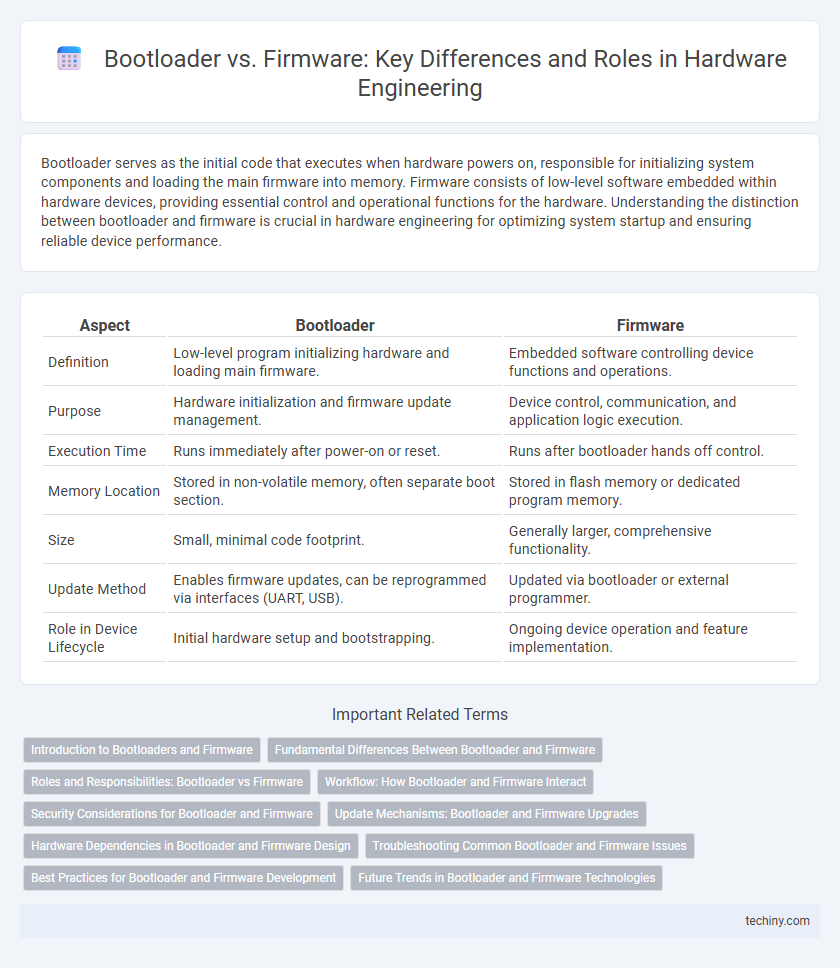Bootloader serves as the initial code that executes when hardware powers on, responsible for initializing system components and loading the main firmware into memory. Firmware consists of low-level software embedded within hardware devices, providing essential control and operational functions for the hardware. Understanding the distinction between bootloader and firmware is crucial in hardware engineering for optimizing system startup and ensuring reliable device performance.
Table of Comparison
| Aspect | Bootloader | Firmware |
|---|---|---|
| Definition | Low-level program initializing hardware and loading main firmware. | Embedded software controlling device functions and operations. |
| Purpose | Hardware initialization and firmware update management. | Device control, communication, and application logic execution. |
| Execution Time | Runs immediately after power-on or reset. | Runs after bootloader hands off control. |
| Memory Location | Stored in non-volatile memory, often separate boot section. | Stored in flash memory or dedicated program memory. |
| Size | Small, minimal code footprint. | Generally larger, comprehensive functionality. |
| Update Method | Enables firmware updates, can be reprogrammed via interfaces (UART, USB). | Updated via bootloader or external programmer. |
| Role in Device Lifecycle | Initial hardware setup and bootstrapping. | Ongoing device operation and feature implementation. |
Introduction to Bootloaders and Firmware
Bootloaders are specialized programs that initialize hardware and load the main firmware during the device startup process. Firmware refers to the embedded software providing low-level control and functionality for hardware components. Both bootloaders and firmware are critical in hardware engineering for ensuring proper system initialization and device operation.
Fundamental Differences Between Bootloader and Firmware
Bootloader is a low-level program that initializes hardware components and loads the main firmware during the device startup phase, serving as the bridge between the hardware and the firmware. Firmware is the core software embedded in non-volatile memory that controls and manages the hardware's functions and operations during normal device use. The fundamental difference lies in their roles: bootloader is responsible for system initialization and loading firmware, while firmware provides the essential operational instructions and control logic for the device.
Roles and Responsibilities: Bootloader vs Firmware
The bootloader initializes hardware components and loads the main firmware into memory during the system startup process, enabling the device to transition from power-on to operational state. Firmware controls device-specific functions by managing hardware resources, executing core application code, and providing interfaces for user interaction and peripheral communication. While the bootloader ensures secure and reliable firmware loading and update processes, the firmware is responsible for real-time operation and feature implementation within embedded systems.
Workflow: How Bootloader and Firmware Interact
The bootloader initializes the hardware and loads the firmware into memory, establishing the foundation for system operation. Firmware contains the essential code that runs the device's functions after the bootloader completes its task. This interaction ensures seamless transition from hardware startup to full software execution within embedded systems.
Security Considerations for Bootloader and Firmware
Bootloader security is critical for ensuring the integrity of device startup by verifying firmware authenticity through cryptographic signatures, preventing unauthorized code execution during the boot process. Firmware security focuses on protecting the embedded software from tampering and vulnerabilities by implementing secure update mechanisms, memory protection, and encryption of sensitive data. Robust security protocols in both bootloader and firmware layers are essential to guard against attacks such as code injection, rollback, and unauthorized firmware modifications in hardware engineering.
Update Mechanisms: Bootloader and Firmware Upgrades
Bootloader update mechanisms typically involve a minimal, secure code segment that facilitates the loading and verification of new firmware images before execution, ensuring device integrity during upgrades. Firmware upgrades rely on the bootloader to write the new firmware to non-volatile memory, often using protocols like UART, USB, or OTA (Over-the-Air), allowing seamless system updates without hardware intervention. Secure boot processes integrate cryptographic checks within the bootloader phase to verify firmware authenticity, preventing unauthorized code from running on embedded systems.
Hardware Dependencies in Bootloader and Firmware Design
Bootloaders require intimate hardware knowledge to initialize processors, memory interfaces, and peripherals for system startup, ensuring a reliable boot sequence tailored to the specific microcontroller or system-on-chip architecture. Firmware design depends heavily on the hardware configuration, including sensors, communication modules, and power management units, to optimize performance and resource utilization. Both bootloader and firmware must address hardware dependencies like clock settings, memory maps, and I/O configurations to ensure seamless integration and functionality of embedded systems.
Troubleshooting Common Bootloader and Firmware Issues
Troubleshooting common bootloader and firmware issues involves verifying firmware integrity through checksum or cryptographic signature validation to prevent corruption during updates. Identifying bootloader errors often requires checking boot sequence logs and ensuring correct memory mapping to avoid hardware initialization failures. Resolving firmware-related problems may include updating device drivers and resetting configuration parameters to recover from incompatibility or corrupted states.
Best Practices for Bootloader and Firmware Development
Effective bootloader development requires minimal size and robust security features to ensure safe and reliable system startup, with mechanisms for secure firmware updates and rollback protection. Firmware development best practices emphasize modular design, hardware abstraction layers, and thorough testing to enhance maintainability and system stability. Both bootloader and firmware must incorporate version control and integrity checks, such as cryptographic signatures, to prevent unauthorized code execution and ensure seamless device operation.
Future Trends in Bootloader and Firmware Technologies
Future trends in bootloader and firmware technologies emphasize enhanced security measures, including hardware-backed authentication and secure boot processes to prevent unauthorized code execution. Advances in over-the-air (OTA) update capabilities enable seamless and reliable firmware upgrades, minimizing downtime and reducing maintenance costs. Integration of machine learning algorithms within firmware is emerging to optimize hardware performance and enable predictive diagnostics in embedded systems.
Bootloader vs Firmware Infographic

 techiny.com
techiny.com